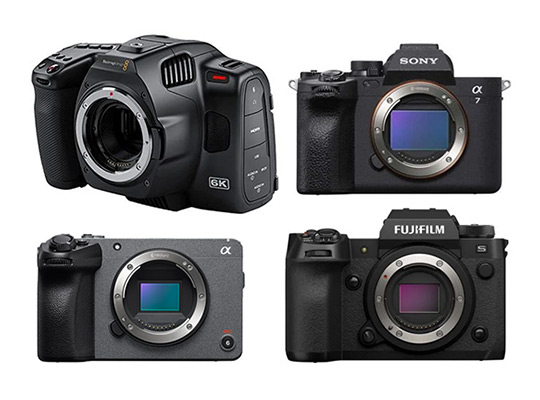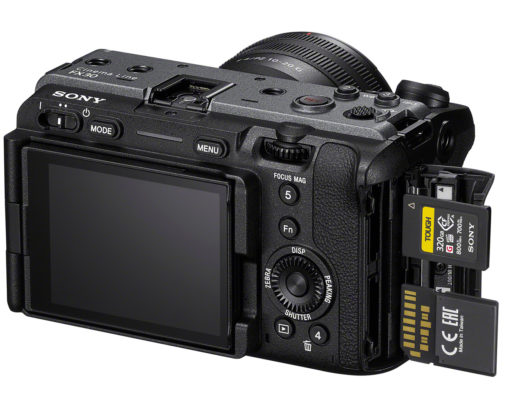Browsing for which camera to buy to shoot your next video can be a daunting task – mainly because the field has become so tight. That is a fantastic thing for us as consumers – manufacturers are constantly pushing each other to bring higher quality and more features to the lower price points. A case in point is this sub $2500 bracket which in 2023 will get you at minimum 4K shot in 10 bit 4:2:2 internally, with fantastic autofocus, image stabilization, full size HDMIs, USB-C power delivery and much more.
The answer to which is the best video camera is really that there isn’t one. There are a number of questions you have to work through which will cross some of the options off your list and after that it will depend on what you value and your particular workflow. For example, personally I value dynamic range and highlight roll off a lot. I also hate video that’s too sharp if I can sense that it’s digital sharpness rather than true resolution. But your values may be different depending on your audience and what platform you are delivering for. So this is personal to some extent and if you think differently, do let me know in the comments!
My top tier – Blackmagic, 2 x Sony and Fujifilm
I have chosen four cameras that I think edge ahead of the pack: the Blackmagic Pocket 6K Pro ($2535 – close enough!), the Sony A7 IV ($2500), the Sony FX30 ($1800) & the Fujifilm X-H2S ($2500) – in no particular order. After that I cover their main competition.
[Update April 2023: The Sony ZV-E1 ($2200) would now be an option – it’s got the full frame sensor from the FX3 / A7S III, but is very limited in record times before it overheats & in some other ways, so you’d have to be pretty sure you were never going to need it for a proper shoot & for that reason I can’t recommend it.]
First up a handy spreadsheet of some of the key data:

Notes:
- Pricing – is rounded to the nearest 5 to be more clear and avoid marketing
- Sensor size – Super 35 and APS-C are close enough to treat them as equivalent when searching for cameras
- Resolution – approximate – I am not bothered about C4K vs UHD etc but you may be – see manufacturer’s sites for full specs – usually the top spec involves a crop or limited functionality
- Dynamic range – taken from the excellent lab tests at Cine D, here I’m using the more realistic 2:1 signal to noise ratio figure (so it will be lower than what is quoted by the manufacturer)
- IBIS – In body image stabilization – useful for handheld shooting and vintage glass
- TC – Timecode – the ability to jam sync timecode from a device like a Tentacle Sync
- ND – Built in ND filters
What are the key considerations?
- Do you need a hybrid? My rules is: if you need a hybrid, buy a hybrid, if you don’t, just get the best camera for your needs whether it is one or not – but bearing in mind that a hybrid can overheat as it usually doesn’t have active cooling.
- Will your older lenses fit? Most older lenses can be adapted to most mirrorless cameras, but you should check out the available adaptors from the likes of Metabones, Sigma or from each camera manufacturer.
- Will your newer lenses fit? Newer lenses from the mirrorless ranges can’t be adapted – for example Canon RF, Sony E, Nikon Z, Fujifilm X or M4/3 – so choose carefully before you buy into an ecosystem.
- Continuous autofocus for older lenses? If this is something you use, it doesn’t tend to work across brands via adaptors, for example Canon EF lenses on a Sony.
- Full frame or Super 35? This is a case of pros and cons – full frame means shallower depth of field which many want, but more expensive, larger lenses and less use of vintage glass. That said most full frames can be put into crop mode when you need it. Super 35 / APS-C gives you a crop factor which you need to allow for, but it might suit you if shooting far away subjects.
- 6K or 4K? If you’re delivering 4K/UHD, it is a bonus to shoot more than that and have the leeway to crop in or stabilize, but it may not be a deal breaker for you.
- Cards – I haven’t covered that particularly as I don’t think it swings things that much, unless you happen to have a good collection of say CFast or CFexpress, then you might want a camera that takes what you have. Though you can just shoot on a good SD card on any of them if you’re happy with H.264.
- Extra features? There are many other features that may or may not be important to you – I will cover key ones below
1. Blackmagic Design Pocket 6K Pro
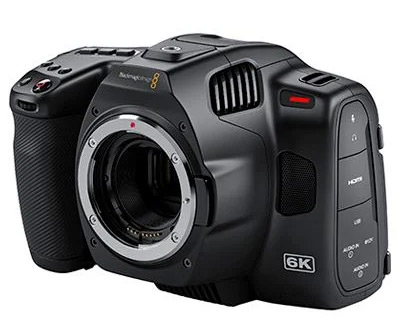
First off, let’s look at the major outlier in the group, the Blackmagic Design Pocket 6K Pro ($2535). The no. 1 thing to consider with the Pocket 6K Pro is that you are locked into using lenses that have the Canon EF mount (or the PL mount if you don’t mind modding the camera). The thing is, a lot of people have a collection of EF glass and don’t want to buy into a new lens line-up, so for those people it can be a great option.
What else sets it apart? It is the only camera with built in ND filters (a massive bonus to not be fiddling around with a vari-ND for every lens change and impressive at this price range), the only one with built in XLRs (albeit mini-XLR which are a bit of a faff) and the only one with a decent sized LCD screen at 5 inches rather than the standard 3 inch of all the others. It’s also a lot bigger and almost twice as heavy as the others – this has pros and cons – it can look more professional to some clients to have a bigger camera & handle better, but requires a more heavy duty gimbal if shooting on one and is heavier to carry for all day shoots. It’s the only one that shoots RAW internally and BRAW is a great format – it is 12 bit log equivalent to 16 bit linear. You can also record to an external SSD which is useful and it has perhaps the most simple and user friendly menu system.
On the negative side, it is the only camera here without a useable continuous autofocus, without IBIS and without a fully articulating screen. That will rule it out for a whole group of videographers and makes it better suited to prosumers or pro DPs who are used to manual focus and using their own bodies for stabilization. The battery life is probably the worst here, though it has the most versatile power input – as well as USB-C power delivery (which all the cameras now have), you can rig up Sony NP or even V-Lock batteries to power it via the Weipu connector.
2. Sony A7 IV
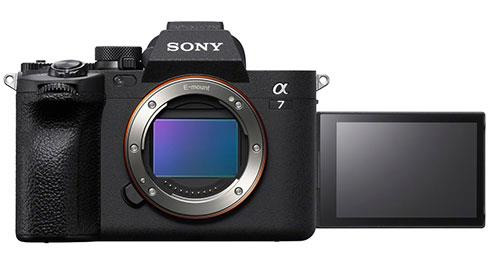 If you shoot video and stills and need a hybrid, the Sony A7 IV ($2500) is a great option at this price point. But even for the video-only shooter there are some reasons why you might choose it over the FX30 which comes next. First up it’s full frame. It has incredible dynamic range and low-light capabilities – even beating the much more expensive A7S III on DR tests. Both the A7 IV and the FX30 have the industry leading autofocus and IBIS – this can make life much easier for run and gun shooting or vlogging. Both have some neat features like the focus map and lens breathing correction and gyro data.
If you shoot video and stills and need a hybrid, the Sony A7 IV ($2500) is a great option at this price point. But even for the video-only shooter there are some reasons why you might choose it over the FX30 which comes next. First up it’s full frame. It has incredible dynamic range and low-light capabilities – even beating the much more expensive A7S III on DR tests. Both the A7 IV and the FX30 have the industry leading autofocus and IBIS – this can make life much easier for run and gun shooting or vlogging. Both have some neat features like the focus map and lens breathing correction and gyro data.
On the other hand, not everyone loves the complicated Sony menu system which can take a bit of time to research and get used to. The rolling shutter is not great on this camera unless you’re in crop mode. It shoots 4K60, but only in Super 35 crop mode, with the full sensor starting at 4K30. Probably the biggest thing against it would be the possibility of overheating if you are shooting continously or in warmer climates.
3. Sony FX30
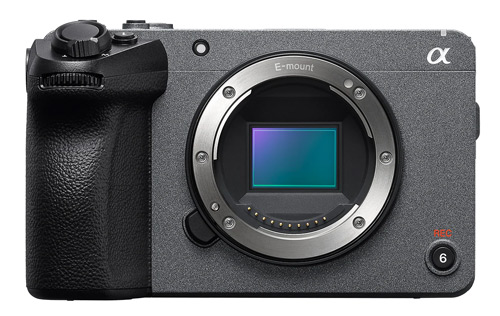
The Sony FX30 ($1800) is the odd one out price-wise – at a solid $700 cheaper and given that I think it competes here aside from price, it is easily the best value contender. It has the classic Sony industry leading AF and IBIS, the same colour profiles like SLOG3 or S-Cinetone, similar inputs and outputs, gyro data, etc. and the same fairly poor rolling shutter. Dynamic range is said to be good, but I haven’t seen enough proper tests yet and so far I think it’s lower than the A7 IV.
Aside from the smaller sensor, the big thing that sets it apart from the A7 IV is it being a video-first camera, part of Sony’s Cinema Line (which includes the FX3, the FX6 and FX9 and even the Sony Venice), with very limited photo shooting capabilities and no EVF. The body is much better suited for video rigs, with many 1/4″ mounts and better button layout. A big thing is that is has a built in cooling fan designed to overcome the overheating blues that hybrids can suffer from – and in the menu you can set it to run minimally while shooting and then spin up when you’re not. And it’s even got a thumb zoom lever which works with some lenses like the Sony 18-105mm f/4 which is bundled in some kits.
For an extra $400, still within our budget, you can buy it with the XLR top handle, which provides pro level audio and is handy for handling the camera (the A7 IV does also have an XLR top handle for an extra $600). The FX30 adds some pro video features which the A7 IV doesn’t have, like being able to jam sync timecode or import custom LUTs and Cine EI mode which some will find useful though it’s worth looking into it before using it. It can also record 16 bit RAW externally.
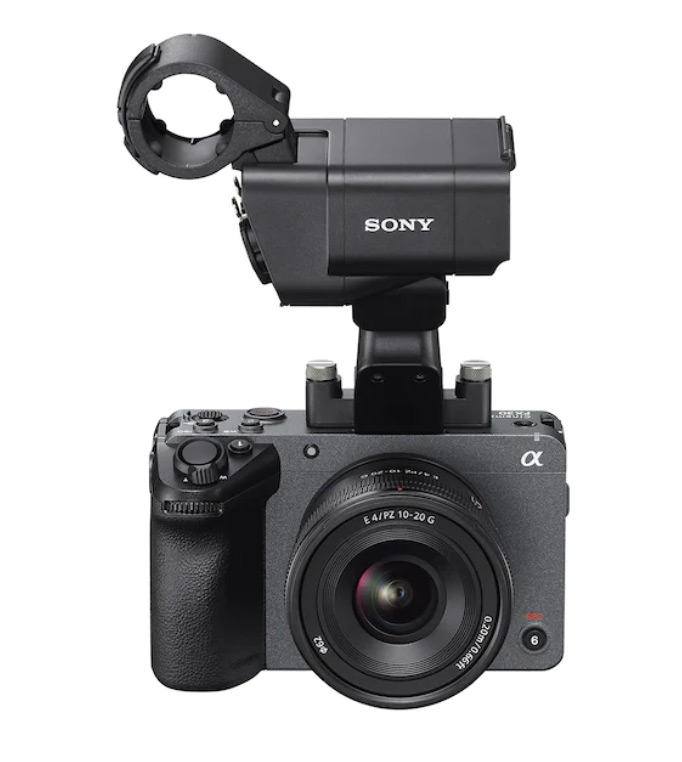
The top spec of 4K120 is only with a large crop but still can be useful, but it shoots 4K60 without a crop. It can shoot up to 240fps at 1080p which is better than the A7 IV. It currently has better firmware too, though the A7 IV is rumoured to be getting the upgrade very soon. There’s a lot going for both Sony options (here’s a good video to help you decide) and which is better will depend on your specific needs.
4. Fujifilm X-H2S

Over the last few years, Fujifilm have developed a fair amount of admirers, especially with the Fujifilm X-H2S ($2500).
The sensor has a new stacked X-Trans engine which some would argue has the best image quality of all the cameras featured here with its 14 bit sensor readout. A stacked sensor means a quicker camera with fantastic rolling shutter performance. In camera ProRes recording is very welcome and can save a lot of time in post as the majority will either transcode or make proxies from H.264/H.265 files, though it will fill up cards quicker. The autofocus and IBIS are only ok and not as good as Sony’s. But being able to shoot 6K 3:2 is great for shooting for simultaneous vertical and landscape delivery or for anamorphic lenses. It can also shoot 4K120, with a slight crop and 4K60 with none.
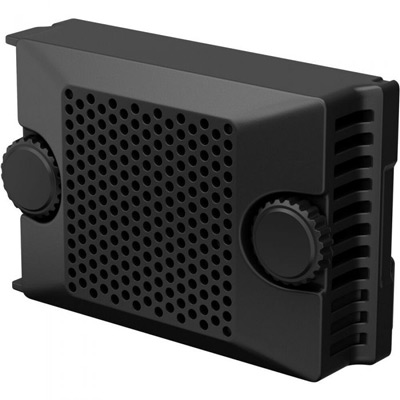
Though Fujifilm don’t sell an XLR top mount, Tascam do for $500. Also, although it is a hybrid, you can buy a cooling fan for it for $200, though I’m not sure it can be as cleverly controlled as with the FX30. The menu is pretty complicated and not that well suited to video, so again will suit someone who doesn’t mind putting in the time to get familiar with it.
Best of the rest
While I think these manufacturers below are a smidgeon behind in the video game at this price point, it’s really not by that much. And for anyone who is already invested in one of these ecosystems or just prefer the look or feel of these brands, it will make a lot of sense to look at one of these cameras instead.
Panasonic S5 II
Whilst you may have expected here the latest in the much loved GH series, the Panasonic Lumix GH6 ($2200) which has probably the most video friendly features of any camera (and of course is great if you have M4/3 lenses), or perhaps the Lumix S1 ($2500), I’ve gone for the newly released Panasonic Lumix S5 II ($2000) which is just coming into stock now in various stores. And even better if you can wait til the end of May will be the S5 IIX ($2200) with some significant video add-ons like internal ProRes, recording to SSD and RAW over HDMI.
The big thing is that Panasonic have finally cracked phase detect auto focus in the S5 II and that it has auto focus compatibility with EF lenses. Personally I’ve never fallen in love with Panasonic colours and image quality, but this full frame hybrid certainly packs a punch in terms of features.
Canon R6 Mark II
The R6 Mark II ($2500) is a full frame hybrid with the RF mount. You can easily adapt EF lenses to it as well, with quite a few options of adaptor – with a focal reducer, a simple pass through or a drop in filter adaptor which is very handy to use and becomes a bit like having built in NDs. And crucially, autofocus works with EF lenses, which isn’t the case for most of the cameras above.
It has good IBIS, great autofocus, decent rolling shutter and those lovely Canon colours. It also has a Tascam XLR adaptor available. It shoots 4K oversampled from the 6K sensor, and while it does overheat at 4K60, other modes are fine. It has lower dynamic range than any of my main choices, which is one of the main reasons I don’t recommend it, as well as the lack of support for third party lenses, but it’s still a great option.
Nikon Z6 II
The Nikon Z6 II ($2000) is certainly not a bad camera, it’s full frame with the Nikon Z mirrorless lens mount, but with only 8 bit 4:2:0 internal recording with no log and a 30 minute time limit, it is behind the pack. You can get 10 bit log recording externally, avoid the time limit and even shoot BRAW with a very good dynamic range, but you need to factor in the RAW upgrade ($200+shipping) and an external monitor into the cost.
Any other options?
The Sigma fp L ($2500) could be worth a look, with pretty decent lab results, as could the RED-esque box style Z CAM E2-S6 ($2200) or Panasonic Lumix BGH1 ($2000), though these are designed to be built into proper cinema rigs so the total cost will be a lot more. Or you could look into the second hand market for an older C300 or FS7 say if you are after a bigger camera and don’t need the latest tech.
One thing I’ve learned doing all this research – the field has never been this close and you can get fantastic results out of any of these cameras.

Filmtools
Filmmakers go-to destination for pre-production, production & post production equipment!
Shop Now